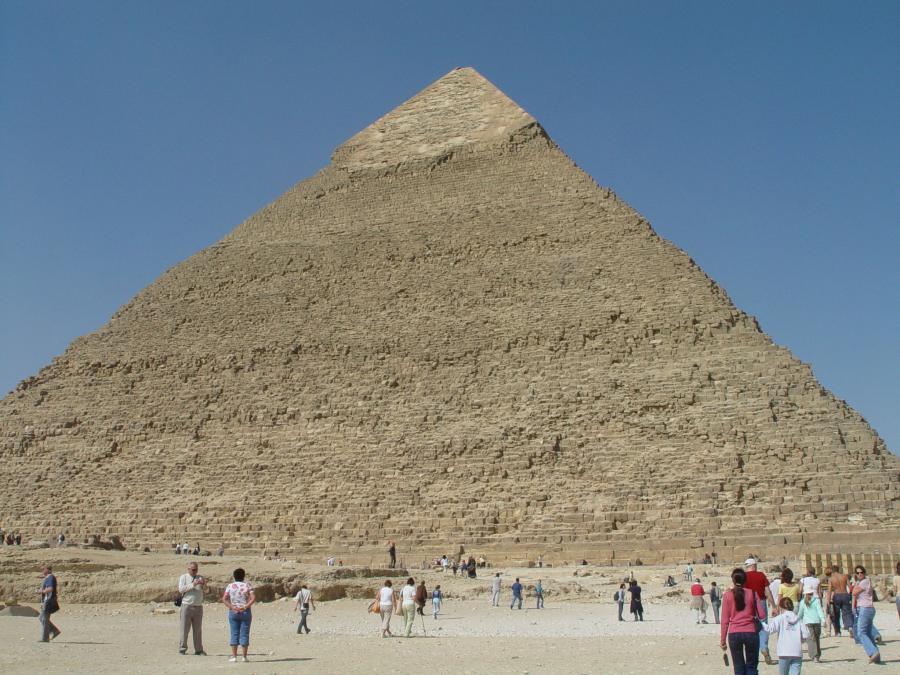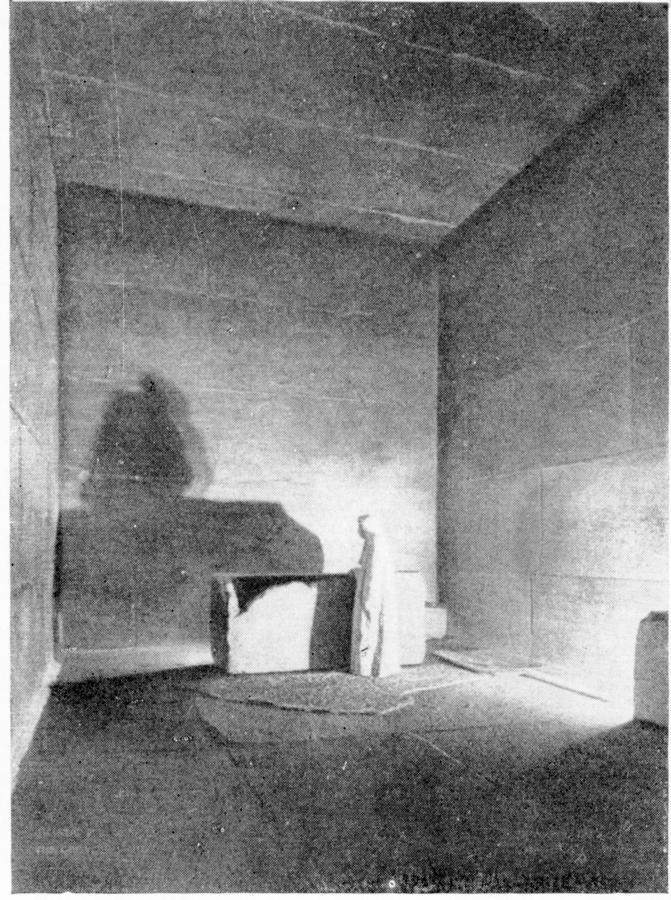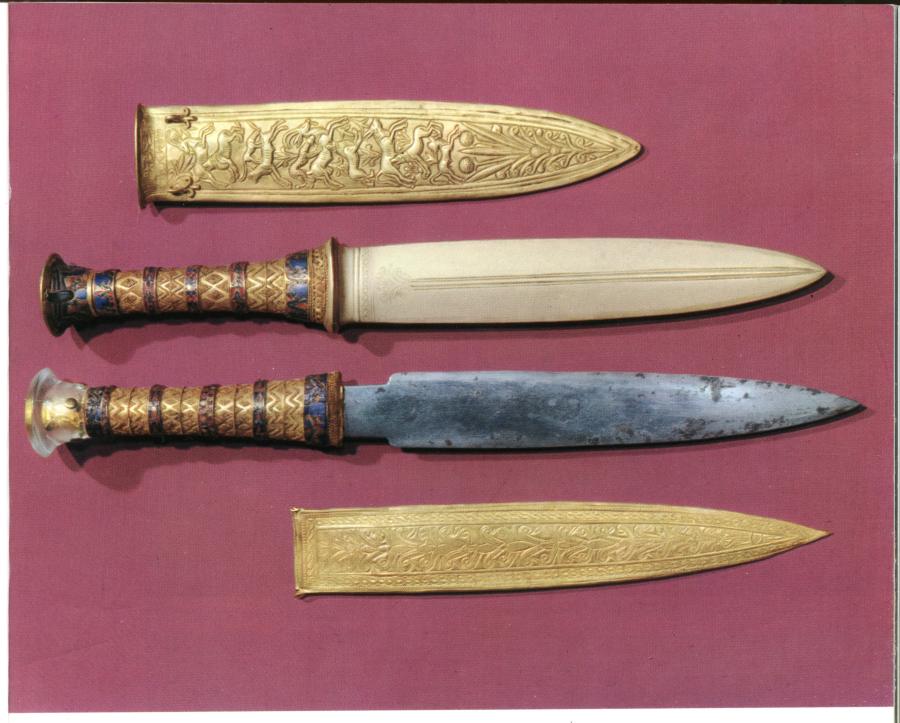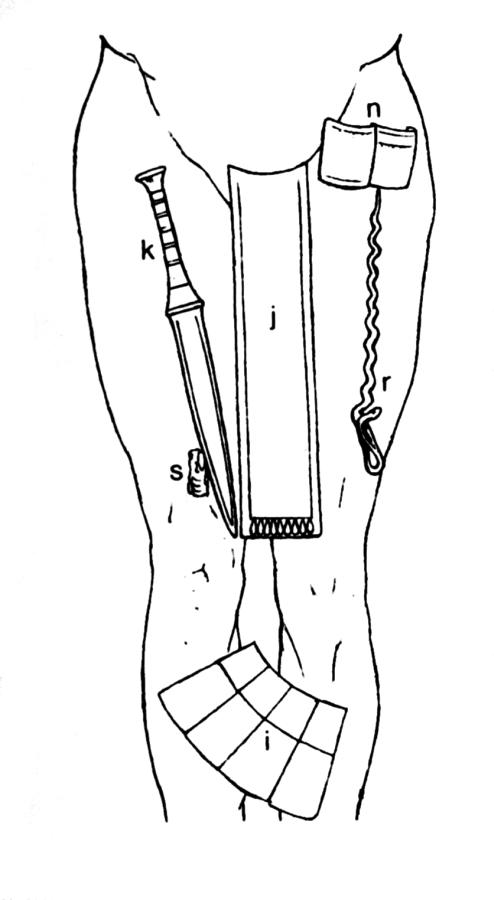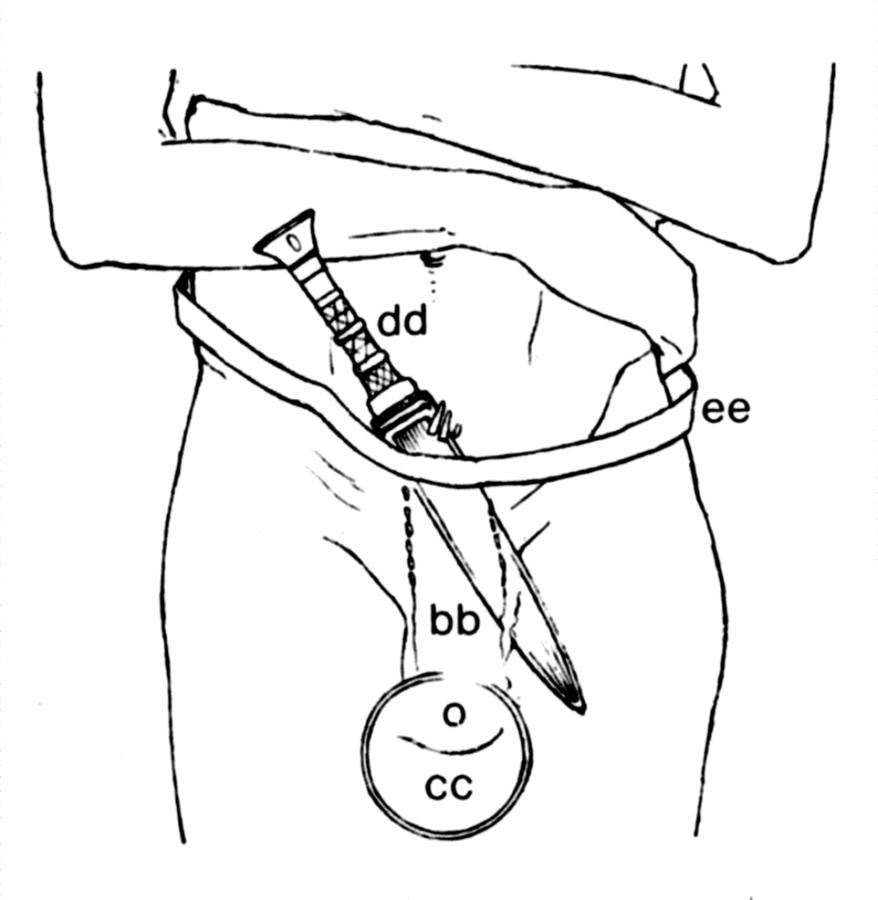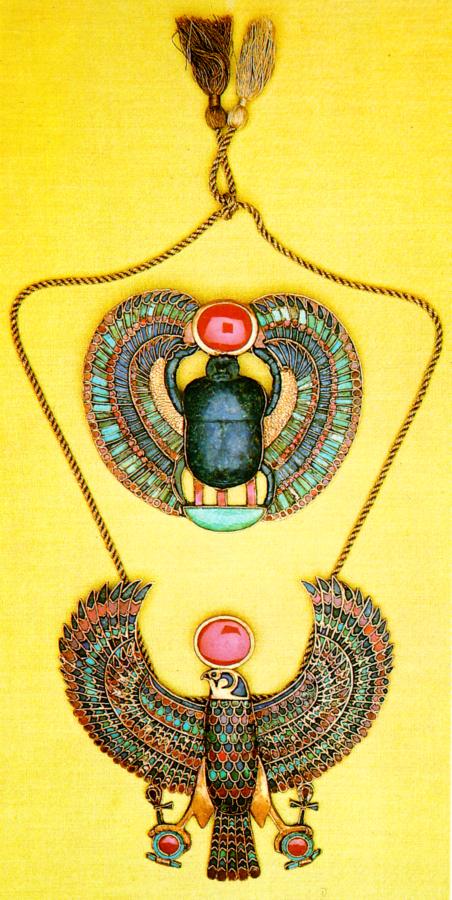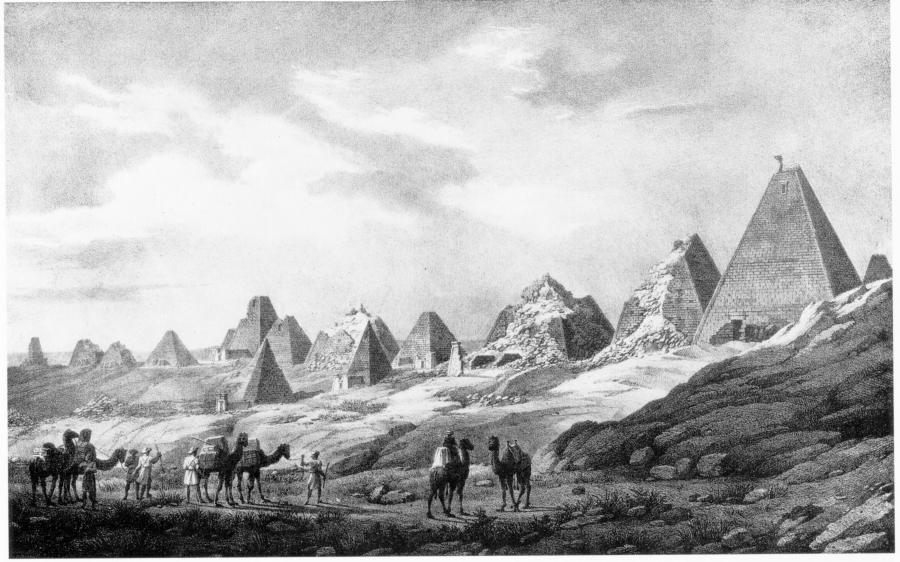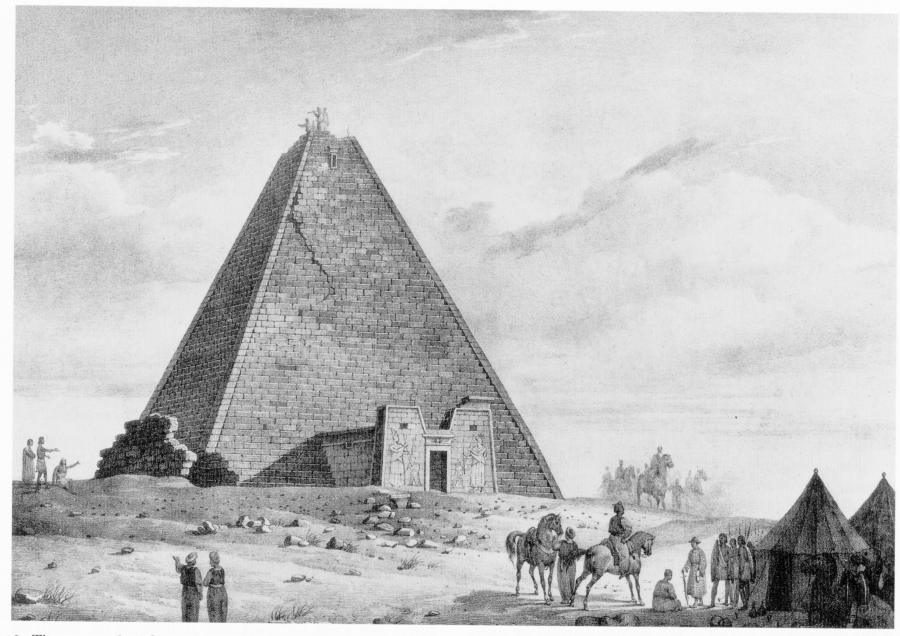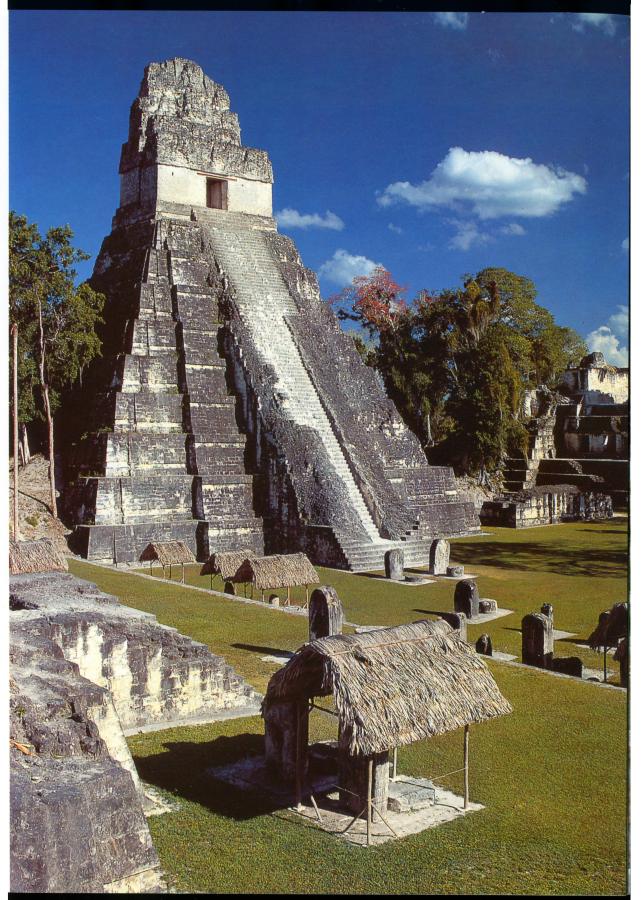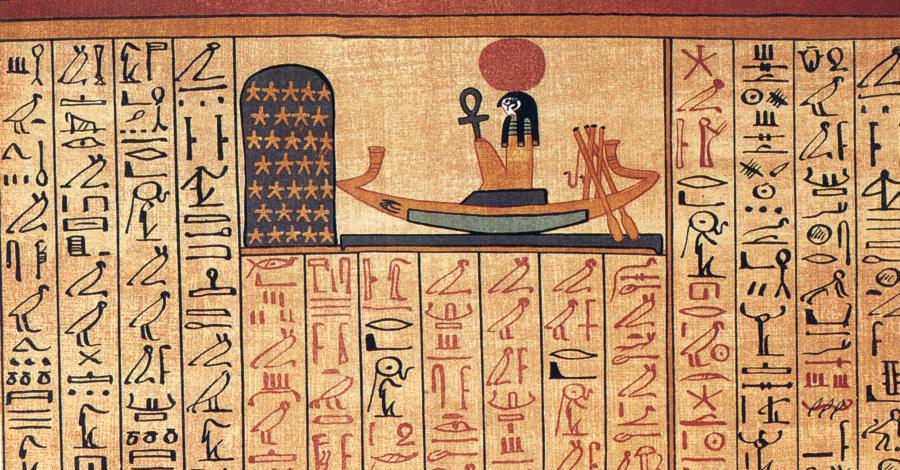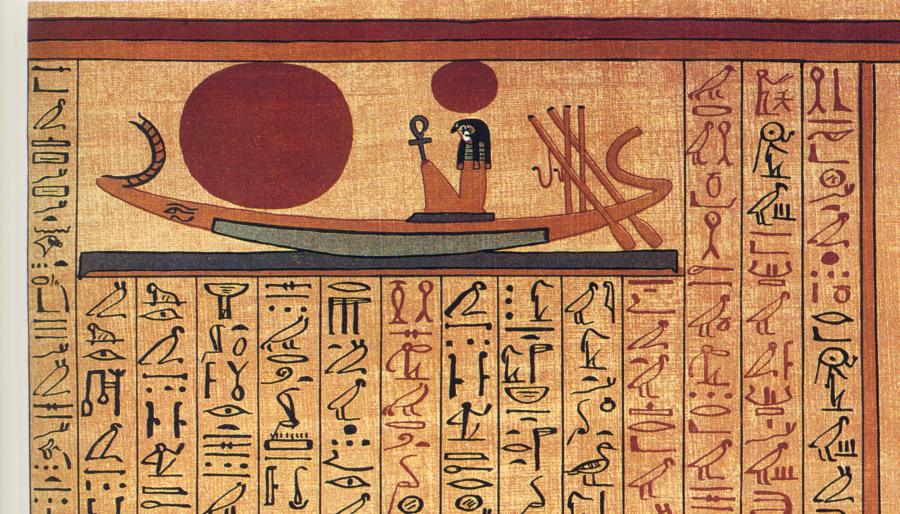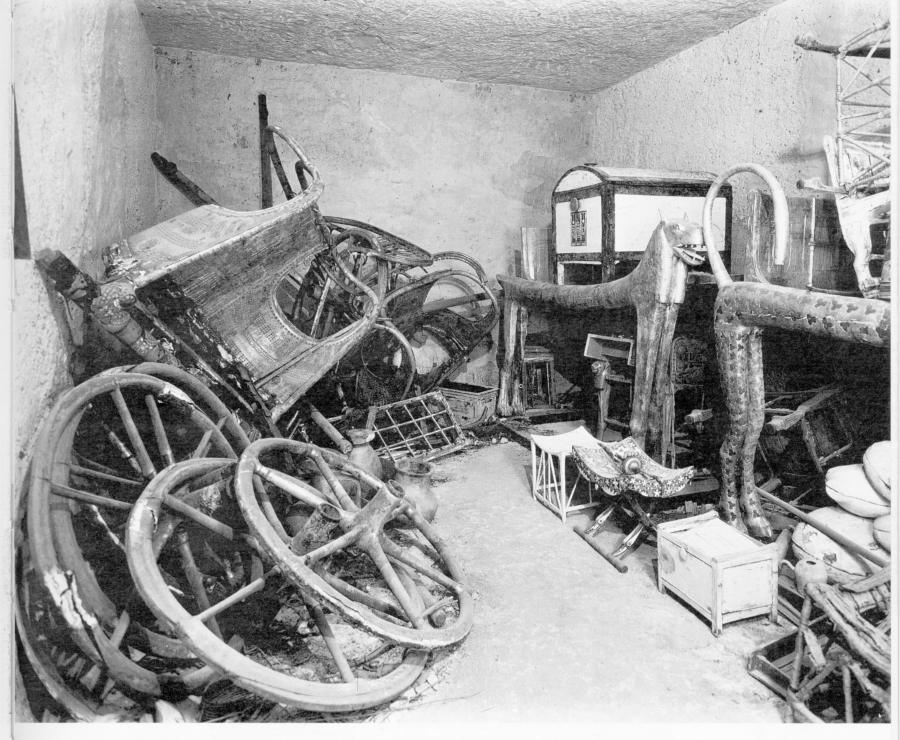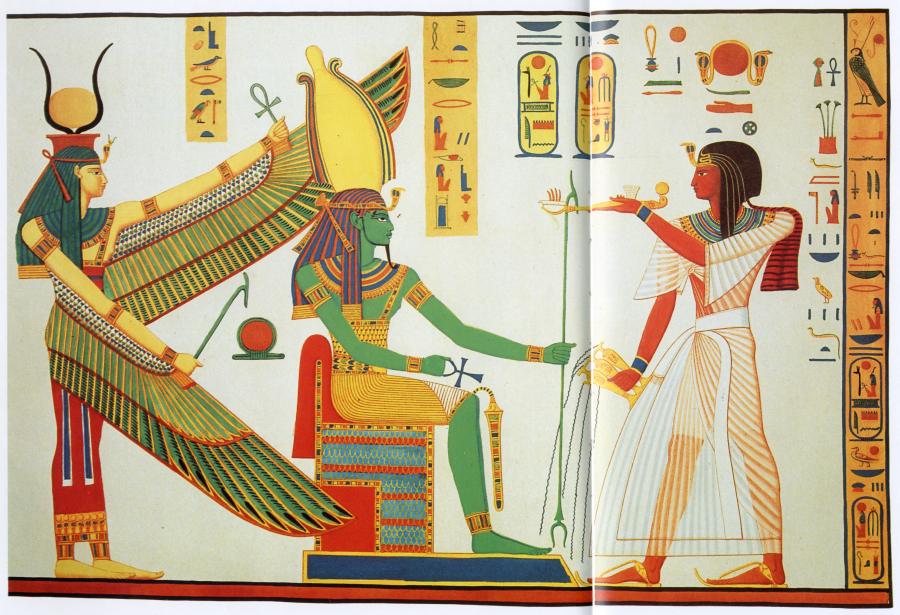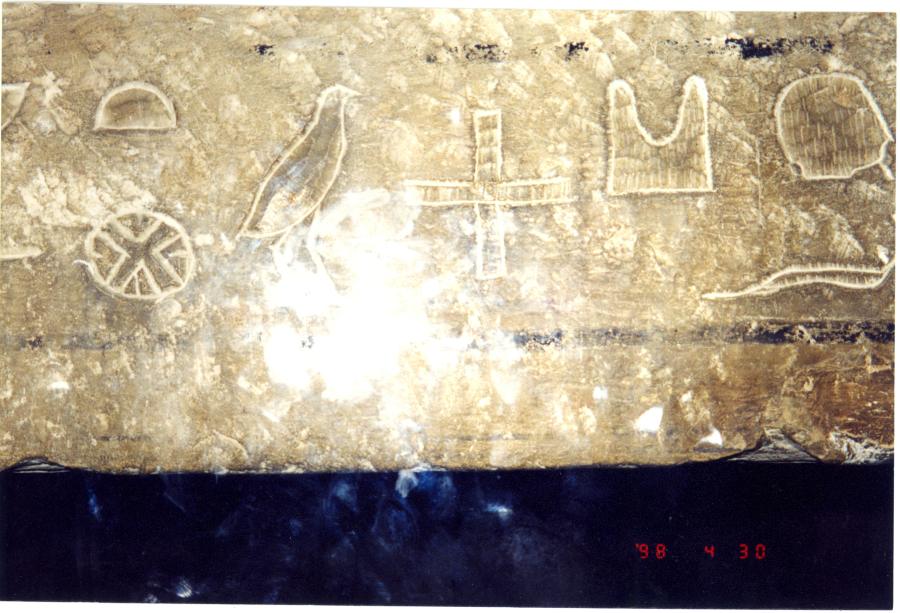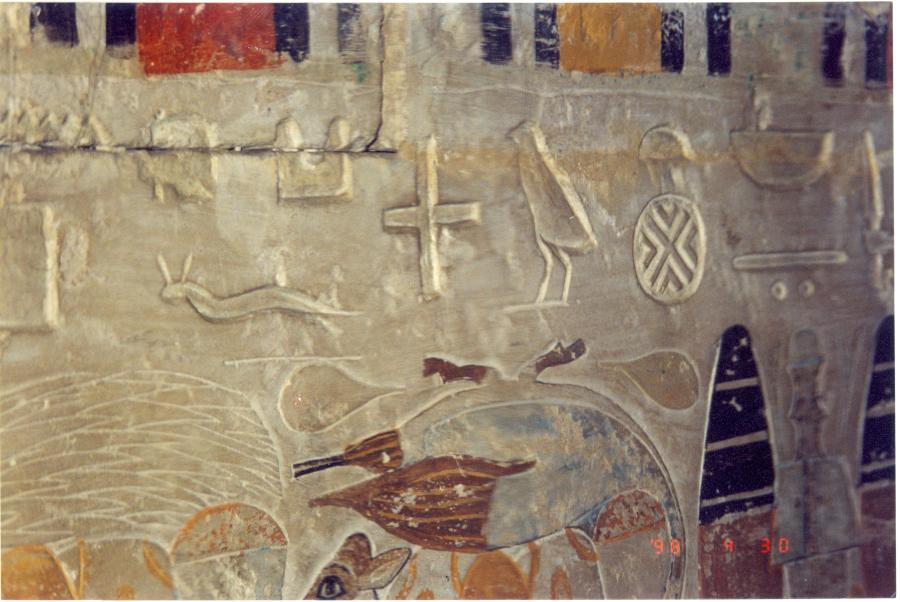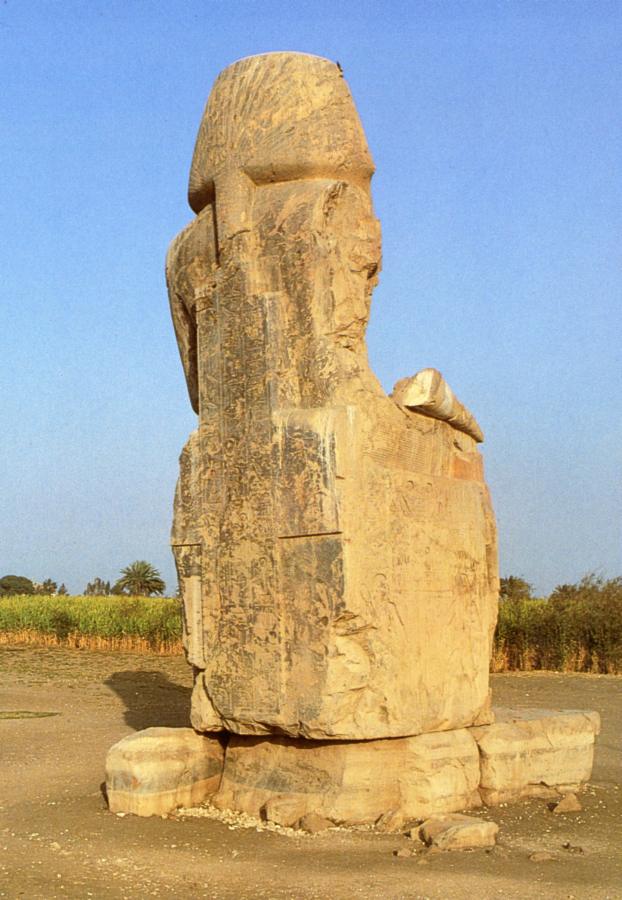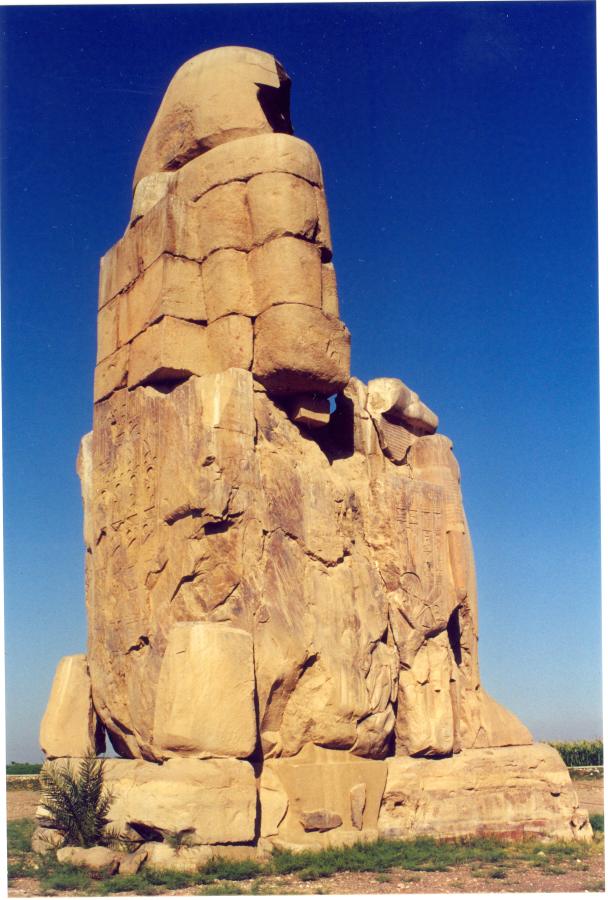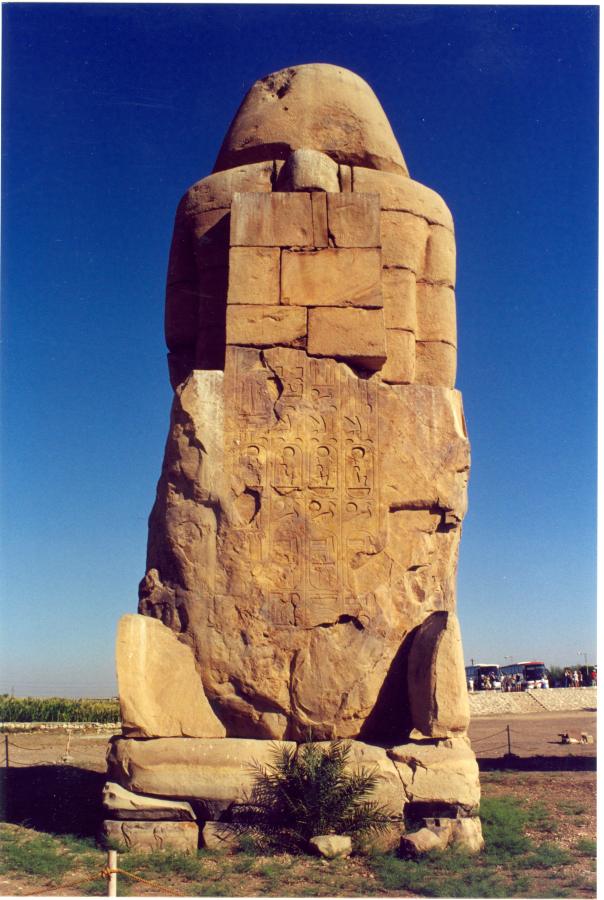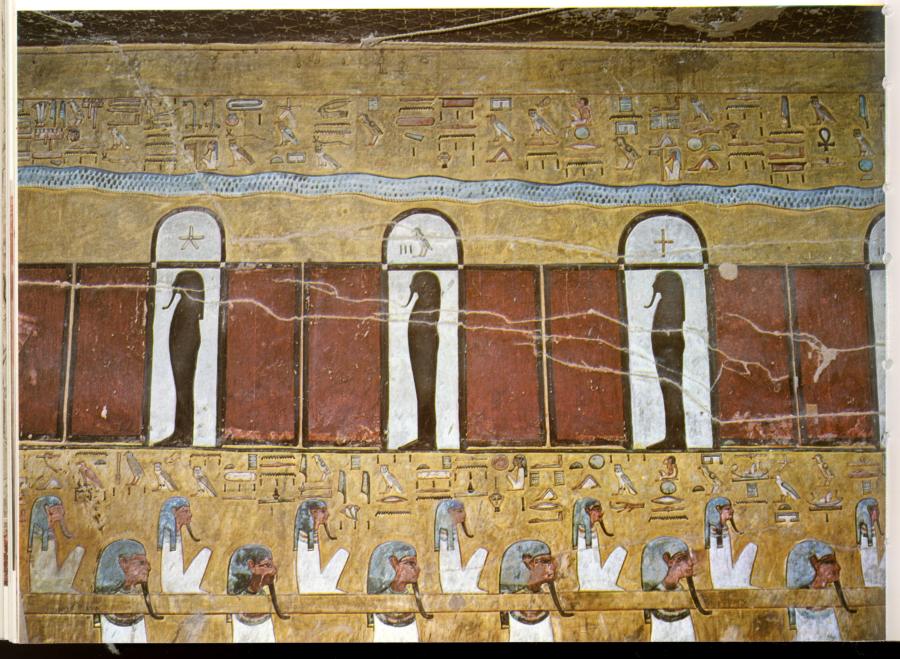Part 5.
Ancient Egypt as part of the Great “Mongolian” Ataman Empire of the XIV-XVI century.
Chapter 19.
“Ancient” African Egypt as part of the Christian “Mongolian” Empire of the XIV-XVI century - its primary necropolis and chronicle repository.
5. The gigantic funereal complexes of the "ancient" Egypt as the main imperial "Mongolian" cemetery of the XIV-XVI century. The identity of Tutankhamen.
5.1. Imperial "Mongolian" cemetery of the XIV-XVI century.
Therefore, according to the New Chronology, the pyramids of Egypt weren't built in deepest antiquity, as Scaligerian history suggests, and date from the relatively recent epoch of the XIV-XVI century in reality. The most famous ones are the Great Pyramids on the Field of Gizeh near Cairo (see figs. 19.25 and 19.26).
According to our reconstruction, the old imperial graveyard of the royal Horde dynasty comprised of the famous Field of Gizeh, or Cossack Field, and Luxor, was the final resting place of the Great Khans who ruled the Great Empire, in particular - Czar (or Khan) Georgiy Danilovich, also known as Genghis-Khan.
In fig. 19.27 one sees a photograph of the burial chamber in the Cheops Pyramid, the way it looks today. At the bottom of fig. 19.28 there is an iron dagger discovered in the tomb of Pharaoh Tutankhamen, right on his mummy ([1366]). The respective positions of the iron and golden dagger on the Pharaoh's body are indicated in figs. 19.29 and 19.30. Iron armaments in the tombs of the "ancient" Pharaohs blatantly contradict Scaligerian chronology, and correspond with our reconstruction perfectly well. Incidentally, the sheath of the golden dagger is decorated with artwork that depicts Czars hunting animals that resemble bulls or deer with hounds (see fig. 19.31). Czars of the Horde, or Russia, were very fond of this pastime. It has to be noted that we see no African animals here, such as lions, camels etc.
It turns out that the iron dagger isn't the only iron object found on the mummy of Tutankhamen. Carter, the archaeologist who discovered the tomb, reported the following: "There were 143 objects inserted between the layers of fabric, including a diadem, daggers, personal amulets and jewellery. Three of said objects have an amazing property - they were made . . . of iron" ([728], page 29).
We already reproduced a photograph of a piece of jewellery found in the tomb of the "ancient" Pharaoh in fig. 16.9 (see [1366]). The imperial eagle is holding an orb with a Christian cross on top of it. What we see is a famous mediaeval symbol of the Empire.
In fig. 19.32 we see the pyramid field upon the northern cemetery of Meroe located in the region of Middle Nile. This is how these places looked in 1821 ([1350], page 7). Fig. 19.22 depicts the pyramid ascribed to the "ancient" Queen Amanishakheto the way it was in 1821 ([1350], page 9). One must pay close attention to the fact that similar pyramids were built in America. In fig. 19.34 we see the mediaeval pyramid known as "The Temple of the Jaguar", which is located in Guatemala ([1270], page 83). It is very similar to the "ancient" Egyptian pyramid, or burial mound, qv in fig. 19.33.
Many golden items were found in the pyramids of Meroe. They were described in the book entitled "Gold of Meroe", for instance ([1350]). It has to be noted that the vast field of Meroe is but a small part of the Egyptian territories occupied by funereal constructions.
According to our reconstruction, the famous sepulchral complexes of the "ancient" Egypt were the imperial graveyards, where the Czars, or Khans, of the Great = "Mongolian" Empire were brought for their burial, as well as other distinguished citizens of the Empire. Their bodies were embalmed before the long journey - for the obvious reason of preventing putrefaction. See the two illustrations to the "ancient" Egyptian Book of the Dead reproduced in figs. 19.35 and 19.36 ([1448]). Apparently, what we see is the transportation of the dead across the "River Styx", or the Mediterranean. Let us once again recollect the "ancient" Greek myths about Charon, the ferryman of the dead, who took the dead to Hades on his boat. As we realise now, Hades can be identified as the Valley of the Nile in Egypt, which was the very "Kingdom of the Dead" as seen by the inhabitants of the "Mongolian" Empire. The name "Charon" is possibly a derivative of the Russian words "khoronit" and "pokhorony" ("to bury" and "burial", respectively).
We learn that the ancient name of Cairo, located right next to the Great Pyramids, was Latopolis ([370], page 56). Historians tell us: "Giza, or Gizeh, is the modern name given to the gigantic necropolis of the ancient Latopolis (known as Cairo today)" ([370], page 56). The word "Latopolis" must have stood for "Tomb City", "lat" being a possible derivative of "klad", the root of the Slavic word "kladbishche" ("cemetery").
The very scale of the funereal complex construction works in Egypt clearly indicates that the delta of the Nile was part of some large and powerful state whose royal cemetery was located in these parts. Historians fail to realise it and fantasise about burials of pharaohs, envisaged as local rulers, being the most important and almost only occupation of the "ancient" Egyptians. One has to be aware of the fact that the lavish burials and the sheer amount of valuables (gold etc) that were buried alongside the deceased would have to comprise a small part of the state treasury. And we know that certain Egyptian tombs remain unmatched in what concerns the volume of gold and gemstones found there. Their lavishness is unique, and no such tombs have ever been found in any other part of the world. However, Egypt is hardly the richest country in the world, and the richest deposits of gold are located at a considerable distance from Northeast Africa.
It would be very edifying to conduct a chemical analysis of gold from the "ancient" Egyptian tombs. It would tell us volumes about the geographical origins of the metal. For some bizarre reason, this hasn't been done to date. Scaligerite historians and Egyptologists are very fond of pontificating about the "mysteries of the pyramids", yet ignore as simple a matter as the source of the gold found in the Egyptian tombs.
In fig. 19.37 we see one of the chambers that comprise the tomb of the "ancient" Egyptian Pharaoh Tutankhamen ([1366], page 79). The dismantled Pharaoh's chariot looks distinctly like the well familiar carriages of the Russian Czars and the European rulers; similar vehicles are exhibited in the Armoury of the Muscovite Kremlin.
In fig. 19.38 we see a fragment of a mural from the Egyptian tomb of the "ancient" Pharaoh Ramses III. The Pharaoh is holding a Christian cross in his hand; the goddess behind his back has her hand stretched out in the typically Christian blessing gesture ([1415], pages 118-119). The goddess has an Ottoman crescent on her head.
The "ancient" Egyptian crosses reproduced en masse on the pages of modern books on the history of Egypt usually have a loop at the top; they are known as ankhs or Coptic crosses. These are the crosses we see in the reproductions mentioned above. In reality, there was also a great abundance of regular Christian crosses in the "ancient" Egypt - without any loops. However, modern historians are mysteriously reluctant to mention them. In fig. 19.39 we see a fragment of some "ancient" Egyptian artwork with a dove and a Christian cross shaped just like the modern crosses. The photograph was taken in the Metropolitan Museum of New York.
In fig. 19.40 we reproduce a picture of the "ancient" Egyptian Obelisk of Iunu crowned by a huge Christian cross. The latter has no loop and has the exact same shape as the conventional Christian crosses. This obelisk was of great significance - it was built in Iunu, or Heliopolis, one of the most important religious centres in Egypt. According to historians, "the ancient Egyptian City of Pillars, or Iunu, also known as Onom, remained a religious centre of paramount importance for almost three thousand years. The Greeks baptised it Heliopolis - 'City of the Sun' . . . In the middle of the III millennium B. C. Heliopolis became the centre of the cult that worshipped the Almighty Creator as the God of Sun" ([486], page 15). As we realise today, the Christian Egyptian city of Heliopolis really emerged as an important religious centre in the XIV century the earliest. Its formidable obelisks were built in the XV-XVIII century. Incidentally, has the obelisk topped with a large Christian cross survived? Why are we only shown a drawing of this monument today? Could it have been destroyed in the course of the Napoleonic programme aimed at "helping Egypt to go towards the light" (see [484], pages 80-82)?
In figs. 19.41 and 19.42 we reproduce two photographs taken in the Egyptian Museum of Cairo in 1999. They were kindly provided by G. A. Khroustalyov, as well as many other interesting materials on Egyptian history that he had discovered. What do we see in the photographs? Typical Christian crosses. Also mark the crosses circumscribed by a circle, which symbolises a halo. They are sometimes called "Qatar crosses". Such crosses were very common in mediaeval Europe (France and Spain in particular, qv in CHRON6, Chapter 9:7).
In CHRON3 we have already reproduced a photograph of the famous "ancient" Egyptian Memnon Colossi. It is assumed that they were built about three thousand years ago ([370], page 136). Their height is around 18 metres; each of them weighs some 1.300 tons ([370], page 136). A view of their rear sides can be seen in fig. 19.43. There is a huge Christian cross carved on the throne of the rightmost monument as seen from behind (fig. 19.44). The left side of the cross is damaged. We see lettering of some sort. We must emphasise that the cross we see isn't a Coptic ankh, but rather the very common wide Orthodox cross (modern Catholic crosses are more narrow).
It is hard to make out the original artwork of the leftmost figure's throne - this monument was defaced to a greater extent than the others (fig. 19.45). Nevertheless, we see vague traces of an identical wide Orthodox cross carved on the back of the throne (fig. 19.46). It had also borne some hieroglyphic inscription.
Thus, both of the "ancient" Memnon Colossi allegedly dating from the XIV century B. C. were built as enormous Christian symbols. The gigantic statues of the "ancient" Egyptian pharaohs sit upon thrones adorned with Orthodox crosses.
One's attention is also drawn to the picture from the side of the throne of the colossus on the right (fig. 19.47). Two human figures stand at the sides of the T-shaped cross and appear to be lifting it upwards using a rope tied around the cross. As we have already mentioned, such T-shaped crosses are also known to us from the Christian tradition, although they are not all that common today (see CHRON1, Chapter 7:6.1). As a matter of fact, the crosses that were carved on the ancient Russian headstones also had three points, although they were Y-shaped rather than T-shaped. One might turn to CHRON4, Chapter 6:3.2, for instance, and study the reproduction of an old headstone with a forked cross from the Old Simonov Monastery in Moscow. Therefore, the shape of the "ancient" Egyptian crosses is similar to that of the ancient Christian crosses characteristic for the Horde. This scene carved on the side of the throne of an "ancient" Egyptian colossus most probably depicts the famous Christian feast of the Holy Cross Day. This must have been indicated in the hieroglyphic inscription found on the same side of the throne.
Let us however return to the Egyptian Museum in Cairo.
On the left of fig. 19.48 we see an "ancient" Egyptian image of the famous medieval Christian symbol - the STATE CROSS. Here the cross is also without the "ear."
An ordinary Christian cross. As we said above, the power of the Christian cross is "ancient." Egyptians also depicted it in the clutches of the imperial eagle.
On the fig.19.49 we see a five-pointed star, which happens to be yet another version of the cross. Over the head of the figure on the right there is a regular Christian cross - not an ankh, qv in fig. 19.50. This cross consists of two narrow bars, just like the modern Catholic crosses. It has to be noted that nearby one sees three figures with the following symbols: a five-pointed cross, a bird and a four-pointed cross. However, two of them (the four-pointed cross and the bird) are famous Christian symbols, the former being the symbol of Christ, and the latter representing the Holy Spirit. In this case the artwork in question represents the Christian Trinity - the Father, the Son and the Holy Ghost. Apparently, the Father's symbol was the five-pointed cross or star.
Vestiges of Christian artwork can still be found in certain "ancient" Egyptian temples. For example, in the Karnak Temple of Amon "remains of murals were found on some of the pillars . . . which leads one to the assumption that this hall was transformed into a church by the Christians" ([2], page 66). It is most likely that no such "transformation" ever took place - this temple was Christian from the very beginning, with corresponding artwork.
Yet we are still being told that the "ancient" Egyptian pharaohs lived many centuries before Christ, having filled the entire "ancient" Egypt with mediaeval Christian symbols. This must be blatantly untrue. The "ancient" Egyptian culture as we know it dates from the Middle Ages, primarily the epoch of the XIV-XVI century, when Egypt in Africa became the central necropolis of the Czars, or Khans, of the Great = "Mongolian" Empire.
It is for this reason that the Pharaohs were called "sons of Ra" ([2], page 4). Historians are trying to convince us that the formula refers to the God Ra. However, it is commonly known that Ra is the old name of the River Volga, qv in CHRON2, Chapter 4:1.1. This is how certain "ancient" authors call it ([797], page 1084). Therefore, "sons of Ra" could have meant "natives of the Volga region", which is in perfect correspondence with our reconstruction, since the Czars, or Khans, of the Great = "Mongolian" Empire had their capital in Novgorod the Great, also known as Yaroslavl - a city which stands on River Volga.
5.2. Russian Prince Dmitriy and Tutankhamen.
Let us conclude with another observation concerning Tutankhamen. It would be very interesting indeed to find out who he was. We have to explain that when we call this ruler Tutankhamen, we are following the interpretation of the Egyptian hieroglyphs that transcribe his name in his tomb, and, possibly, certain texts as well. It is most likely that his real name was different. In our reconstruction the royal Egyptian graveyard was the funereal complex of the "Mongolian" Empire. Therefore, Tutankhamen was one of the Empire's princes.
Let us remind the reader that he died in his youth ([1366], pages 24 and 117). One might assume that his grave is one of the most recent on the royal graveyard. Bear in mind that all the graves in the Valley of the Kings were carved in the sides of hills. The actual valley is a long and narrow crevice situated among hills of soft stone. In the middle of the crevice there is a hill that resembles a burial mound; there is a large number of royal graves carved in its sides. There are also many graves in the sides of the crevice. However, it is possible that the central hill, or burial mound, was believed to be the most honourable. There must have been no place left in the hill for Tutankhamen's grave, which is why its entrance was made in the ground nearby and not the hill itself. Then the tunnel made a curve underground and led under the hill, which is where one finds Tutankhamen's burial chamber.
It appears that the plan was to bury him right in this place of honour. However, since it was impossible to bury him in the regular fashion due to a lack of space, the gravediggers chose this idiosyncratic method, which wasn't used for any other tomb of the Valley of the Kings. To put it briefly, one gets the impression that Tutankhamen's tomb was added to the complex at the very end, as one of the last graves in the royal graveyard. However, according to our reconstruction, this implies that the historical original of Tutankhamen has to be searched in the epoch of the XVI century, the one that immediately preceded the dissolution of the Great = "Mongolian" Empire.
It is difficult to make any definite claims about the historical identity of Tutankhamen - however, we feel obliged to voice our opinion on this matter. The fact that he died in his youth, as well as the daggers on his belt (which must have had a special significance), leads us to the thought that Tutankhamen may possibly be identified as Russian Prince Dmitriy. Dmitriy died at the end of the XVI century, accidentally stabbing himself to death with a dagger in a game. This is what one of the versions is telling us about his death, at least. Whether this is true or not can only be estimated from a research of his grave, in particular, a chemical analysis of the gold, which can identify the mines that it came from. Apart from that, it is known that Tutankhamen's body was found floating in some mysterious viscous liquid. It is normally assumed to be a thickened mixture of incense and perfumed oils, which may be true. However, it may also be honey, which was occasionally used in Russia for embalming the dead bodies. There was an abundance of honey in Russia, which means the method in question may have been used. It is unlikely that such a practice existed in the regions that lay further south, however.
All of the above lends some special significance to the fact that a medical expertise discovered a cut in the left side of Tutankhamen's mummy. It is on the left side of the mummy's stomach and runs from the bellybutton - almost horizontally, a little bit towards the bottom ([1366], page 117). Experts use the word "strange" for referring to the location of the cut, nonetheless considering it related to embalming. Yet it is possible that a cut in such an unusual place appeared before embalming, possibly being the very fatal wound inflicted by a dagger that killed Prince Dmitriy. The embalmers may have later used the orifice for embalming purposes. Moreover, a bone fragment was found in Tutankhamen's skull - also a possible cause of death ([1366], page 118). No official statement about the reasons why Tutankhamen died has been made to this day. The opinion of the expert medics is as follows: "Murder as the cause of Tutankhamen's death is beginning to look more and more plausible" ([1366], page 118).
As for the coffin of Prince Dmitriy, parts of which are exhibited in the Armoury of the Kremlin, it is known to have been manufactured in the XVII century - 1630, to be more precise ([187], page 74). Let us recollect that Prince Dmitriy was canonised already in the epoch of the Great Strife, and possibly even later. Romanovian history claims that it happened under Vassily Shouyskiy ([85], Volume 14, page 356). Incidentally, the hagiography of Prince Dmitriy saw its first publication as late as in 1879 ([85], Volume 14, page 357).
Let us now discuss the authenticity of Tutankhamen's tomb and the objects found therein. The discovery of the tomb was accompanied by a number of strange circumstances, and the categorical opinion about all artefacts being forgeries has already been voiced in the press - one might cite the article of Konstantin Smirnov as an example ("The Discovery of Tutankhamen's Tomb in Need of Revision", published in the "Tekhnika Molodyozhi" magazine, April 1998, pages 62-64). We are of the opinion that the issue requires a meticulous study involving laboratory analysis. The falsification hypothesis cannot be proved in any other way. Apart from that, it is possible that the falsification was of a partial nature. H. Carter may have indeed found some authentic artefacts, but a different amount and in a different place. Or, alternatively, most of the authentic ancient artefacts that he found were completely outrageous from the Scaligerian viewpoint and needed to be replaced by "correct objects" manufactured on the spot. The "embarrassing" originals may have been hidden or even destroyed. We are of the opinion that some of the objects found inside Tutankhamen's tomb are authentic; however, this doesn't mean no forgeries are present there. There may be a significant amount of those, maybe even the predominant part of all findings in total. We believe any finite conclusion to be premature so far; yet the issue needs to be considered. At the same time, the actual underground chamber found by Carter gives one good reasons to question its authenticity, qv below.
Let us give a brief synopsis of some oddities pointed out by K. Smirnov.
Firstly, the excavations carried on for five years, and were constantly put on hold by Carter without any coherent explanation. He opened and re-sealed it a number of times. Had everything been legitimate, such procrastination would seem very strange. Indeed, the discovery of priceless treasures would normally be made known to the public as soon as possible, with all the circumstances of the finding documented in detail. This is the natural wish of any discoverer. However, the falsification version makes Carter's unhurried approach perfectly understandable - he needed time for negotiations, the manufacture of numerous "ancient artefacts", finding sponsors and so on.
Another suspicious detail is the alleged multiple penetration of robbers into the tomb - robbers that didn't take anything with them, no less. They have even carved a passage in the rock to divert one of the inner doors - yet they haven't stolen a single thing! At the very least, enormous piles of gold have remained intact. The strangest thing is that the "robbers" blocked up the entrance to the tomb once again, as Carter reports. In the forgery scenario this passage could have served the purpose of adding more "antiquities" to the sealed-up chamber.
The third conspicuous circumstance concerns the so-called "Pharaoh's Curse". The excavations of the tomb began in 1923. By 1930, the only actual participant of the expedition that remained alive was Howard Carter. Over the course of seven years the rest of the team (21 of them altogether) perished under different circumstances. Lord Caernarvon, Carter's sponsor and boss, died in the very same year of 1923 from "blood poisoning caused by careless shaving". His wife, Lady Caernarvon, "expired from a mosquito bite", and so on, and so forth. There were young people among the 21 victims. The situation looked so odd that it gave birth to the myth of "the Pharaoh's curse". K. Smirnov makes the justified observation that it would make more sense to suggest that a large-scale forgery was the case, as well as the tactical removal of eyewitnesses or dissenting parties. Smirnov believes the Egyptian government to have been the initiator of the forgery; their agent was Howard Carter, who had deceived Lord Caernarvon, his initial sponsor.
Although we lack the factual information necessary to share Smirnov's point of view, we have mentioned his article for a reason.
In 2002 G. V. Nosovskiy and V. V. Sundakov, a famous Russian traveller, visited the tomb of Tutankhamen in the Valley of the Kings, Luxor, and inspected it meticulously. As a matter of fact, this is the only tomb where it is forbidden to take pictures, let alone film videos. All cameras are taken away from the visitors. First and foremost, G. V. Nosovskiy and V. V. Sundakov were surprised by the artwork inside the tomb. It is supposed to resemble gilding, and so it does in album photographs, looking just like ancient gilding with black dots where the layer of gold has peeled off.
In reality, if one examines the artwork from a closer distance, it becomes instantly obvious that the coating on the walls is nothing but cheap yellow paint, whereas the dark patches were made with other paint, dark brown in colour. That is to say, the artwork was designed to look antiquated right from the start. Apart from that, in every available photograph of Tutankhamen's tomb the artwork is deliberately photographed from such an angle that it appears to cover the entire space of the chamber walls around the sarcophagus, which is usually the case with all the other tombs in the Valley of the Kings - artwork covers the walls and usually also the ceiling completely.
In case of Tutankhamen's tomb the artwork is a rectangle that covers a whole wall and also parts of the two adjacent walls, with a clearly defined boundary, since it does not cover the whole space available. This rectangle appears right in front of the tourist who walks into the tomb. Areas that aren't quite as accessible to the tourists remain void of artwork for some reason. One gets the impression that it was designed as a tourist attraction - we see nothing of the kind in any other tomb known to us. Moreover, all the burial chambers in the Valley of the Kings have a domed ceiling, usually adorned with a zodiac. This isn't the case with Tutankhamen's tomb - the chamber is perfectly rectangular, which doesn't prove anything per se; yet the numerous other tombs make it look rather odd.
The lid of Tutankhamen's sarcophagus also looks strange - it is made of grey granite, whereas the actual sarcophagus is carved from dark brown stone. In every other tomb the colour of the lid corresponds to the colour of the sarcophagus.
One gets a very strange feeling about this tomb in general.
But why wouldn't Carter make the tomb resemble all the others, if he was indeed responsible for forgery? The answer is simple. As for the tomb, Carter was simply saving money and effort. Why would one make a large chamber with domed ceilings if all the objects found therein were bound to be taken away to Egyptian, European and American museums anyway?
As for Tutankhamen's sarcophagus, Carter was simply unable to manufacture one that would look "ancient". The matter is that all the other sarcophagi from the Valley of the Kings are made of geopolymerous concrete/granite and possess a formidable size and weight. This technology had been forgotten and was only rediscovered in the second half of the XX century by I. Davidovich (see more on this in the next section). Carter wasn't aware of it, and the task of dragging an authentic ancient sarcophagus weighing many tons into the tomb of Tutankhamen must have seemed too complex to him. However, the sarcophagus lid is made of granite concrete and looks authentic. Incidentally, it is broken in two, although we are told that the robbers did not touch the sarcophagus. Could Carter have broken it "by accident", or, perhaps, taken an old broken lid deliberately, since its halves were easier to take inside the tomb?
Nevertheless, some of the objects that Carter "found" in the crypt (currently in the possession of the Cairo Museum) make the impression of authenticity. Therefore it is possible that there are actual findings in the "Tutankhamen collection". Both of the pharaoh's daggers, manufactured with the use of the ancient granulation technique, appear to fall into this category. The knives were found in the fabric that covered the pharaoh's mummy, which means that the latter is very likely to be authentic as well.
Some ancient tomb may have indeed been found, but its content was "edited" by historians and archaeologists. One also shouldn't rule out the possibility of a deliberate large-scale forgery aimed at attracting tourists to Egypt. Only an independent expert study of the findings can share some light over the issue, in particular - an analysis of the gold in order to estimate its origins.
